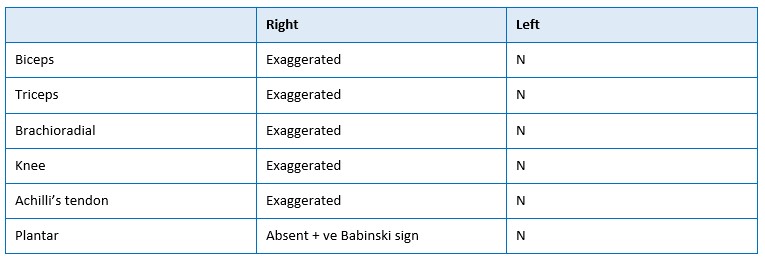A Case Study on Pakshaghata - A Successful Story
DOI:
https://doi.org/10.21760/jaims.9.4.40Keywords:
Pakshaghata, Vata Vyadhi, hemiplegia, Udwartana, BastiAbstract
Pakshaghata (hemiplegia) is a condition that affects half side of the body. Vata Dosha regulates all the functions of the body. Vata Prakopa acts as a main cause for Pakshaghata. Vata Prakopa happens due to Marghavarodha and Dhatukshaya. According to the contemporary science, all the sensory and motor activities are controlled by the brain. Cerebrovascular accidents are mainly responsible for loss of function in the body and due to its similarity, it can be correlated to Pakshaghata as explained in Ayurveda. Pakshaghata can be treated in Ayurveda, with Panchakarma procedures like Mridu Samshodhana and Basti. In the present case, the patient presented with the weakness in the right side of the body. Patient was bed ridden and treated with Panchakarma therapy for 4 months with Udwartana, Basti, Nasya, Abhayanga. After treatment patient was able to walk without any support and other complaints got relived by 80%.
Downloads
References
Charaka Samhita, by Acharya Vidyadhara Shukla hindi translation chikitsa sthana 28 th chapter Vatavyadhichikitsitam adhyaya. P. NO- 687
Charaka Samhita, by Acharya Vidyadhara Shukla hindi translation chikitsa sthana 28 th chapter Vatavyadhichikitsitam adhyaya. shloka no- 53 P. NO- 697
Sushruta Samhita by kaviraja Dr. Ambikadattashastri hindi translation Volume 1 Nidana sthana Vatavyadhi nidana sholoa nor 61. Reprint 2022. Chaukhamba publications Page nor -302
Sushruta Samhita by kaviraja Dr. Ambikadattashastri hindi translation Volume 1 Nidana sthana Vatavyadhi nidana sholoa nor 61. Reprint 2022. Chaukhamba publications Page nor -302
Yogesh T. Kotangale, Anuja Bhojane, & Sumedha Y. Kotangale. (2023). Management of Pakshaghata in Ayurveda - A Case Study. Journal of Ayurveda and Integrated Medical Sciences, 8(2), 175 - 179. Retrieved from https://jaims.in/jaims/article/view/2292
Acharya Sharangadhara, Sharangadhara Samhita Sanskrit text with English Translation by Dr G Prabhakar Rao. Madhyama Khanda, first edition 20013, Ch 02, verse 136.pg no-100.
Charaka Samhita, by Acharya Vidyadhara Shukla hindi translation chikitsa sthana 28 th chapter Vatavyadhi chikitsitam adhyaya. shloka no- 81 P. NO- 701
Pravana J. and Manoj Shankaranarayan, Keraliya chikitsa paddati, 2008, Padmasri Dr. Rajagopalan Ayurveda Granthamala Samithi, Thrisur, Keralapp.68- 69.
Charaka Samhita, by Acharya Vidyadhara Shukla hindi translation chikitsa sthana 28 th chapter Vatavyadhi chikitsitam adhyaya.shloka no- 83 P. NO- 703
Charaka Samhita, by Acharya Vidyadhara Shukla hindi translation siddhi sthana 1st chapter Kalpana siddhi adhyaya. Shloka no- 51 P. NO- 170
Chakradatta Samhita Sanskrit text with English translation by Priyavrat Sharma, edition 2003, Ch- 73, verse 29-31.pg no-628
Bhaisajya Ratnavali by Shri Govinda dasji, English translation by Dr. Kanjiv lochan ji Chaukamba publication Reprint 2009. 29 th chapter amavata chikitsa.
Bhaisajya Ratnavali by Shri Govinda dasji, English translation by Dr. Kanjiv lochan ji Chaukamba publication Reprint 2009. 26 th chapter Vatavyadhi chikitsa.
Sen Kaviraja Sri Govinda Dasa. BhaishajyaRatnavaliwith Siddhipradha Hindi commentary by Dr. Siddinandan Mishra, 2009 ed. Varanasi: Chaukambha Surbharatiprakashan; p504.
Bhaisajya Ratnavali by Shri Govinda dasji, English translation by Dr. Kanjiv lochan ji Chaukamba publication Reprint 2009. 17 th chapter Swarabheda chikitsa, verse no 34-36.
Bhaisajya Ratnavali by Shri Govinda dasji, English translation by Dr. Kanjiv lochan ji Chaukamba publication Reprint 2009. 26th chapter Vatavyadhi chikitsa
Kashinath Shastri, Gorakhnath Chaturvedi. Charaka Samhita Vidyotini Vyakhya Part 1 Charaka Samhita Sutra Sthan 14/20–24. Reprint Varanasi: Chaukhambha Bharati Academy 2017; 286p.
Rasachandamshu Unmada Gajakesari Rasa Rasa. Shloka no- 181,182















